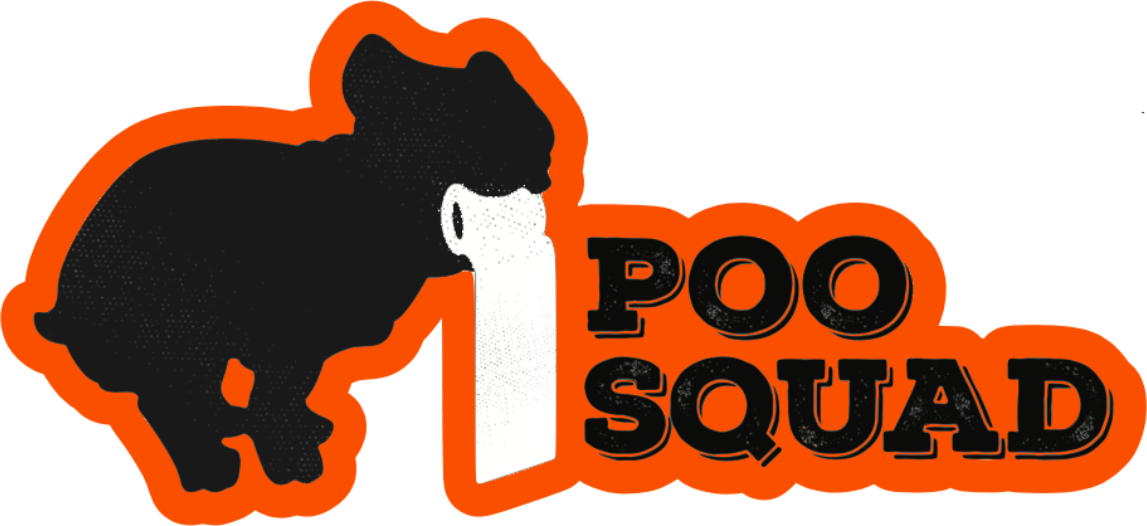Why Dogs Roll in Poop: 7 Ways to Stop It
Dogs roll in poop due to instinctual scent-masking, stress relief, boredom, or learned behavior. This action is rooted in evolutionary camouflage and scent communication, but poses risks like exposure to parasites and bacteria. Rolling often occurs in specific yard areas or after emotional triggers.
To stop a dog from rolling in poop:
- Interrupt early using “leave it” or recall commands.
- Remove triggers by cleaning high-risk yard zones regularly.
- Avoid reinforcement, don’t scold or chase post-roll.
- Use a distraction, like toys or treats, to redirect focus.
- Train consistently using long leashes and positive reinforcement.
- Sanitize with pet-safe products to remove odor cues.
- Consult a vet if the behavior becomes obsessive or causes skin irritation.
This guide addresses root causes, training methods, and how professional cleanup reduces both temptation and health risk in yards with repeat rolling behavior.
The Evolutionary Roots: Why Dogs Are Wired to Roll
Dogs don’t do things to gross us out, though it may feel that way. Rolling in poop has been around long before the tennis ball or the fenced-in yard. To understand it, we need to look back to the wild days when survival meant staying hidden, blending in, and communicating through scent.
Instinct from Their Wild Ancestors
Long before snack-filled pantries and squeaky toys, dogs’ ancestors had to survive in the wild. Wolves are known to roll in the scent of prey droppings, dead animals, and strong-smelling foliage to disguise their scent.
This camouflaging tactic helped them sneak up on prey or avoid becoming prey themselves. That natural drive didn’t disappear when your dog traded the forest for the backyard.
Scent Masking and Camouflage in Modern Dogs
Even though your pup is not hunting elk in Kansas, the instinct to hide their scent still lingers. That’s why you might notice your dog targeting certain smelly areas, especially on walks or in group environments like parks. Rolling in poop can sometimes be a throwback to staying “low-profile” among other dogs.
If this is happening at a dog park or daycare, it could be about social hierarchy or stress. And if your dog’s rolling tendencies ramp up after certain yard visitors or neighborhood pets come through, it’s worth looking into residential clean-up services to keep scent triggers to a minimum.
What Is Your Dog Trying to Say? Scent as a Language
To us, poop smells like… well, poop. But to your dog, it’s a loaded scent profile packed with information. Rolling in it is not only sensory chaos, but it can also be how your dog communicates with the world. This behavior often makes perfect sense to them, even when it baffles us.
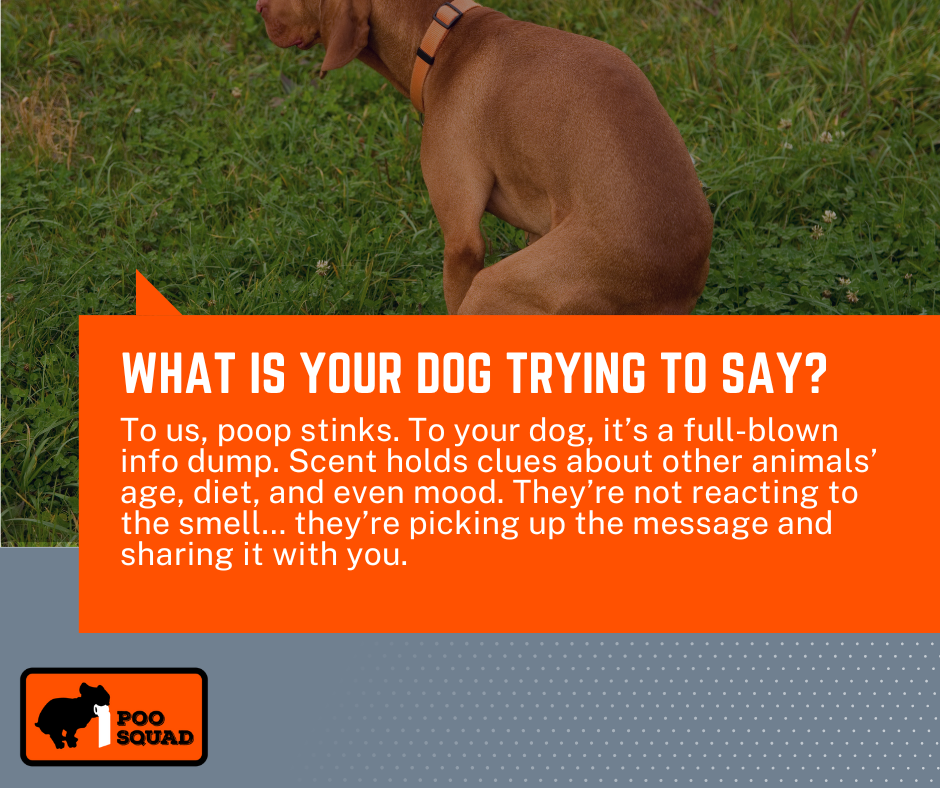
Smell-Based Communication
Dogs rely on scent the same way we rely on conversation. That gross pile in the grass might carry another animal’s age, sex, diet, or even emotional state. When your dog rolls in it, they’re not reacting to the smell; they may be trying to “bring it with them.” It’s like taking notes to share with their pack (you included).
Bringing Home the Message
When a dog rolls in poop during a walk, they might be capturing a scent memory. It’s their way of saying, “Hey, smell what I found!” They could be relaying this to dogs at home or simply carrying it as a badge of curiosity.
If you notice this happening in the same parts of your neighborhood or yard, that’s a clue it might be a hotspot worth addressing with consistent commercial waste removal, especially if you manage shared green spaces or apartment areas.
Environmental & Behavioral Triggers
While instinct plays a big role, a dog’s environment and emotional state can also drive this behavior. Rolling in poop can be a stress response, a learned habit, or simply a weird form of fun. The key is identifying what’s triggering it so you can intervene effectively (without losing your sanity).
Stress Relief and Sensory Stimulation
Some dogs roll when they’re anxious or overstimulated. It might feel soothing or familiar in chaotic environments like busy dog parks or after loud household events.
Rolling may also be a form of sensory play, a way for dogs to “experience” a strong scent with their whole body.
If your pup seems to do this more after routines change, visitors leave, or during storms, stress may be the root.
Learned or Reinforced Behavior
Dogs are great imitators. If they saw another dog roll in poop and got attention from it, positive or negative, they may repeat it. Rolling can also be accidentally reinforced if you laugh, yell, or make a big fuss afterward.
Even chasing them to clean them up can feel like a game. If your dog’s habit started after playing with a new dog or visiting a new daycare, it might be worth reevaluating that environment, or doubling down on training.
Rolling as Enrichment or Fun
Some dogs seem to love it. They sniff, they pause, and before you can stop them, they’re fully committed to a smear job. It’s enriching, wild, and probably a little hilarious to them.
We’ve even given nicknames to repeat offenders: “waddling bandits” for those who smear poop across the lawn, and “Poocassos” for the ones leaving rainbow trails thanks to chewed-up crayons and toys.
The Gross (and Potentially Dangerous) Side of Poop Rolling
While rolling in poop might seem like a quirky personality trait, it’s not all harmless fun. There are legitimate health risks to both dogs and humans, especially if you’ve got kids running barefoot in the yard or a dog that likes snuggling on the couch right after their “adventure.”
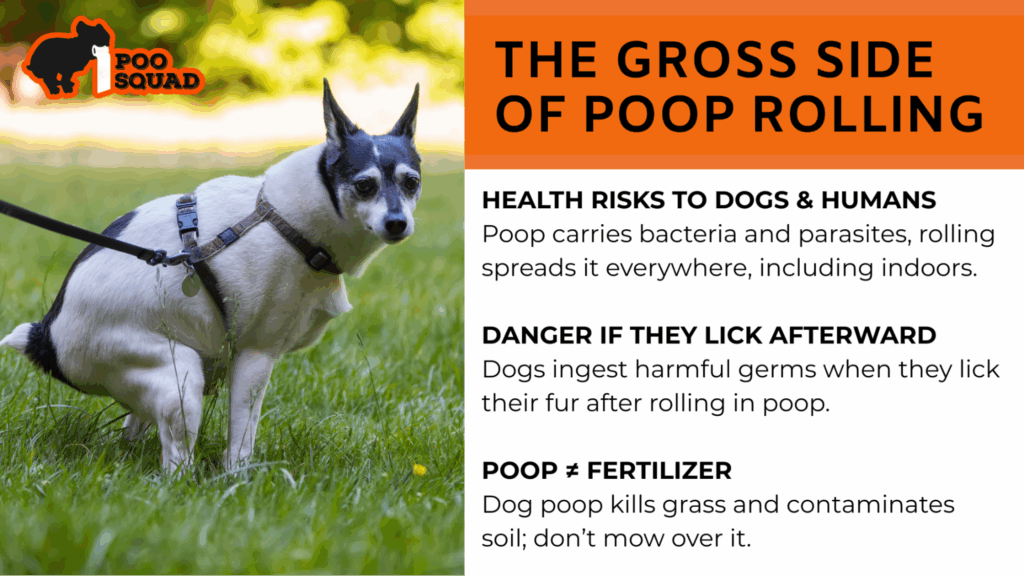
Health Risks for Pets and People
Poop is a bacterial time bomb. It can carry roundworms, hookworms, E. coli, Giardia, and even parvovirus. When a dog rolls in it, they’re smearing these pathogens across their fur, and potentially into your home. Those bacteria don’t disappear with a quick bath, either. It lingers on collars, bedding, and even in your car if you’re transporting them post-roll.
Even worse, if your dog then licks themselves (or you), they can ingest harmful microbes. If your dog’s a regular roller, and you’ve been skipping professional yard cleaning, now’s the time to rethink that. Our sanitizing and deodorizing services not only freshen your lawn, they kill the bacteria and neutralize the smell that invites this behavior in the first place.
Myth: Dog Poop Is Fertilizer
This one gets us every time: “It’s fine, I mow over it and it breaks down.” Wrong. Dog poop is acidic, toxic, and loaded with ammonia and bacteria. It doesn’t fertilize, it kills grass and contaminates groundwater. We’ve seen lawns go from lush to patchy nightmares because folks thought a little poop mulch was eco-friendly. It’s not.
What NOT to Do When Your Dog Rolls in Poop
When your dog comes charging through the yard covered in stink, the natural reaction is to panic, yell, or reach for the strongest soap in your arsenal. But certain responses can make the situation worse, or encourage repeat performances.
Don’t Punish After the Fact
Dogs live in the moment. If you find them post-roll and start scolding, they’re not connecting your reaction to the act of rolling. They’re reading your energy, maybe even thinking you’re upset about being outside or muddy. Punishment can create anxiety, which, ironically, increases the likelihood they’ll roll again as a stress response.
If you didn’t catch them in the act, skip the lecture. Focus instead on reinforcing better behavior next time. Catching the pre-roll signals and using a “leave it” command consistently is far more effective long term.
Avoid Harsh Chemicals or Home Remedies
We get it, your nose is desperate. But dousing your dog in vinegar, bleach mixtures, or random home remedies can do more harm than good. These substances can irritate their skin, dry out their coat, and create associations that make bath time even harder next time.
We recommend using a gentle, pet-safe shampoo and considering a long-term solution to the root cause. If rolling is happening on your property, it’s worth having us handle a professional yard cleanup to remove both the mess and the temptation.
How to Stop Your Dog From Rolling in Poop
Stopping a poop-rolling pup is not about dominance or discipline; it’s about timing, awareness, and changing the environment. Dogs aren’t being defiant when they roll; they’re being dogs. That means your best strategy is prevention, redirection, and a little bit of patience.
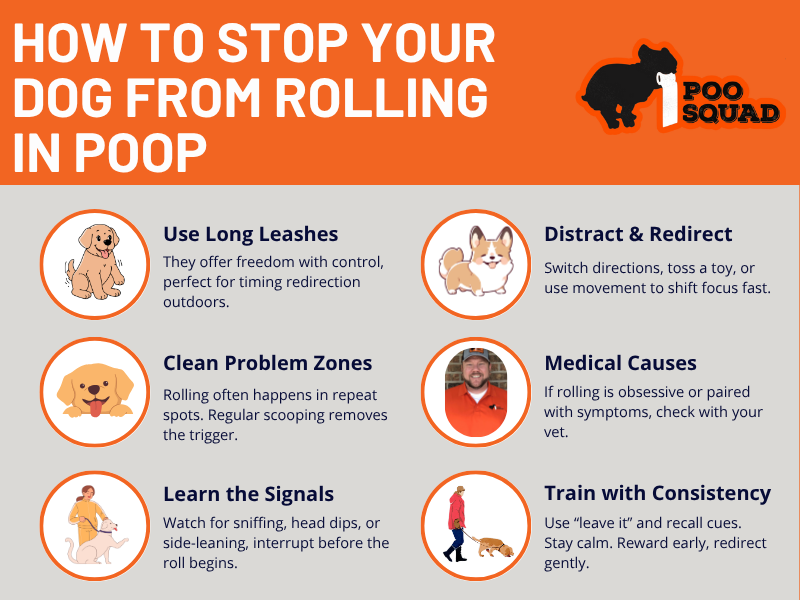
Learn the Pre-Roll Signals
Most dogs don’t plop into poop without warning. They usually sniff intently, pause, and then slowly lower one side of their body, often starting with the head. If you can recognize this moment, you’ve got a split second to interrupt it. A sharp, cheerful “leave it” paired with redirection can work wonders if timed right.
Train with Consistency
Training starts at home. Practice “leave it” and “come” commands indoors, then move them into controlled outdoor spaces. Use high-reward treats and a confident, calm tone. We’ve seen clients gain better results when they stop relying on scolding and instead build up reliable recall skills.
Long leashes are incredibly helpful during this phase. They give your dog room to explore but still keep you close enough to correct or redirect before disaster strikes. If you notice specific areas in your yard that trigger rolling, a consistent pooper scooper schedule helps eliminate those temptations before they have a chance to settle in.
Distraction Techniques That Work
Sometimes the best way to stop a behavior is to offer a better one. Toys, movement, treats, or even switching directions on a walk can redirect your dog’s focus. This is especially important if your dog is already halfway in, yes, we know that dreaded moment. A happy call and a quick toss of their favorite ball can pull them out of the funk and into a more productive mindset.
When It Might Be Medical
If your dog rolls obsessively, ignores all redirection, or pairs this behavior with licking, scooting, or skin irritation, it’s worth getting your vet involved. While rare, certain medical issues or neurological quirks can be at play. Think of rolling as data; if the pattern feels “off,” it probably is.
Pro Tips from the Poop Pros
We’ve seen it all: dogs doing barrel rolls in compost piles, proudly strutting inside with mystery goo on their collars, and owners on the verge of tears. When it comes to poop behavior, there’s not much that surprises us anymore. But here’s the good news: with the right systems in place, this can be prevented.
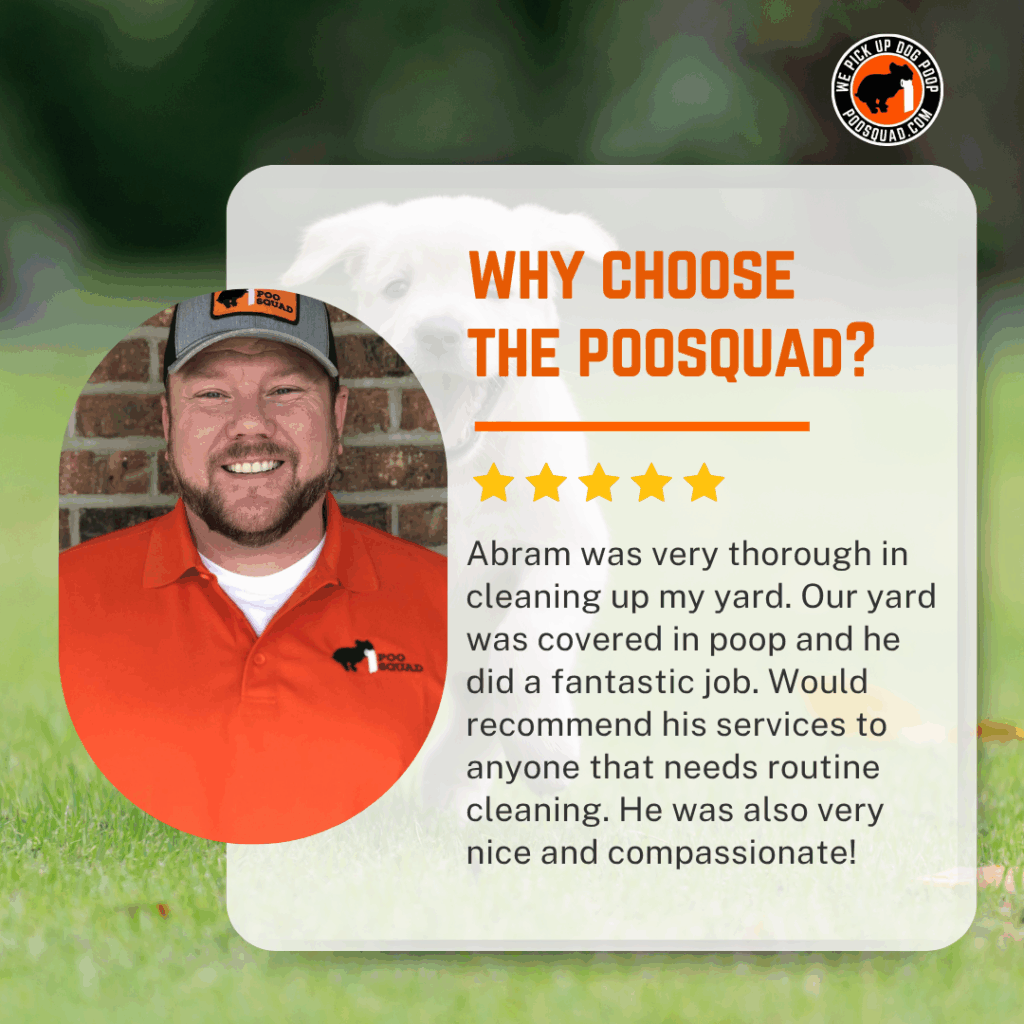
Rolling = Warning Sign
Rolling is not random. It’s a sign that something in the yard or walking route is too enticing to resist. Our team often spots problem areas long before the owners realize what’s happening.
Whether it’s overlooked waste from a neighborhood dog or decomposing matter under a tree, that scent is powerful. We help identify and eliminate these triggers through consistent and attentive cleanup, so you don’t have to discover them the hard way, like on your dog’s shoulder.
Sanitary Best Practices
We don’t cut corners. Our tools and shoes are sanitized between every yard. That means if one dog rolls in something questionable or shows signs of illness, it doesn’t follow us or our clients anywhere else.
And unlike many services, we never use your water, your trash, or your time. Our job is to make your life easier and cleaner, not leave you dealing with leftover stink.
That’s part of what makes our yard sanitation service different. It’s not about scooping poop, it’s about creating a safer, cleaner environment where rolling is not even tempting in the first place.
Concerns from Dog Owners(and How to Solve Them)
You’re not the only one dealing with a poop-covered pup. We hear from frustrated, confused, and even embarrassed dog parents every week. This behavior sparks real emotions, especially when it starts affecting daily life. Here are the most common concerns we hear, and how to work through them.
I Feel So Embarrassed at the Park…
It’s one thing when your dog rolls in poop in the backyard, but when they do it mid-walk or at a dog park, it feels like the world’s judging you. The truth? It happens more often than you think. This is one of the top reasons new clients reach out to us. A clean, professionally maintained yard helps remove the stress of surprise roll sessions before social outings.
Nothing Works… I’m Exhausted
Some owners have tried everything, from fancy leashes to costly behavior classes, and still end up with a dog that can’t resist a pile. The key is consistency, not complexity. Removing the triggers through regular cleanup and reinforcing basic commands works best. It takes time, but the payoff is real.
Is This My Dog Only?
Nope. We’ve seen hundreds of dogs with this habit, across all breeds, sizes, and personalities. It doesn’t mean your dog is weird or broken. It means they’re curious, instinctual, and probably overdue for a supervised yard check. If you’re seeing patterns, we can help pinpoint the source and offer real solutions.
The Clean Solution: How We Can Help
Rolling in poop might be rooted in instinct, but cleaning it up shouldn’t fall entirely on you. From preventative sanitation to behavior insights, we’ve built our entire service model around giving dog parents peace of mind and cleaner yards.
We Notice What You Don’t
Our team doesn’t only scoop and go. We observe your dog’s habits, monitor the condition of waste, and notice behavior changes you might miss, like frequent sniffing in high-risk spots or new rolling patterns. We’ve helped countless clients catch early signs of dietary issues or environmental triggers before they turned into bigger problems.
Pet-Friendly Sanitation Services
We go beyond basic cleanup. Our sanitization and deodorizing treatments target odor-causing bacteria that not only make your yard stink, but also attract your dog to roll. It’s a one-two punch that clears the mess and removes the temptation.
Free Pet Profiles and Customized Dog Tags
Your dog’s safety is part of our mission. That’s why we offer free pet profiles and QR-coded dog tags for our clients. If your dog slips out during a cleaning or playtime, anyone who finds them can scan the tag and contact you instantly. It’s one more way we look out for the pups we serve.
Author: Chief Scooper
Jamie Coones is the founder of Poo Squad. He started the original location in Manhattan, KS in 2017 and has since licensed the brand to another 20 other owners with locations across the country.
